This Special Release (SR) presents the latest available data on women and men in the Cordillera Administrative Region from the 2020 Census of Population and Housing conducted by the Philippine Statistics Authority (PSA). Specifically, this SR discusses the household and institutional population, youth population, marital status, religious affiliation, and functional difficulty, with disaggregation by province/HUC and sex.

More males than females in the Cordillera Region
Based on the results of the 2020 Census of Population and Housing (CPH), the Cordillera Administrative Region (CAR) recorded a total population of 1,797,660 (as of 01 May 2020). Of the total population, 99.6% or 1,791,121 persons were household population while the remaining 0.4% or 6,539 persons were institutional population.
Of the total household population, 917,431 or 51.2% were males while 873,690 or 48.8% were females. More males were recorded in age groups 0 to 59 years old. Meanwhile, more females were recorded in age groups 60 to 80 years old and over. The greater number of women among senior citizens is attributed to the longer life expectancy of women.
Figure 1. Household Population by Age Group and by Sex, CAR: 2020
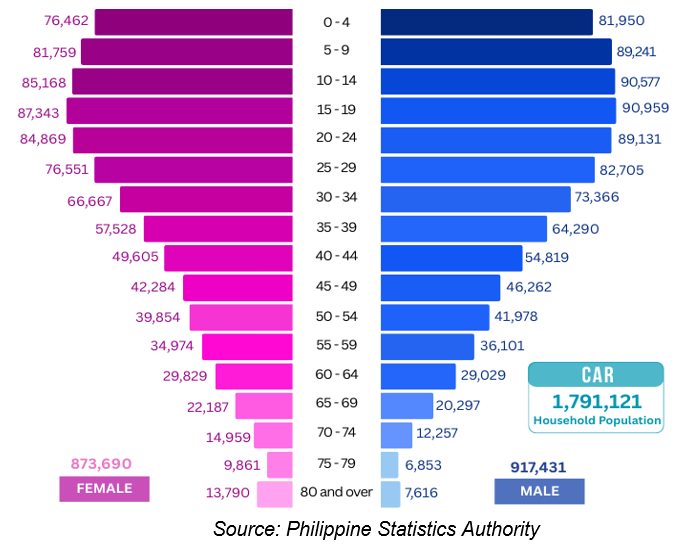
Across provinces and Highly Urbanized City (HUC), Benguet recorded the highest household population with 459,468 (25.7%). This was followed by the City of Baguio, Abra and Kalinga with 363,151 (20.3%), 250,309 (14.0%), and 229,328 (12.8%), respectively. Apayao had the least household population with 123,937 (6.9%).
Figure 2. Household Population by Province/HUC and by Sex, CAR: 2020
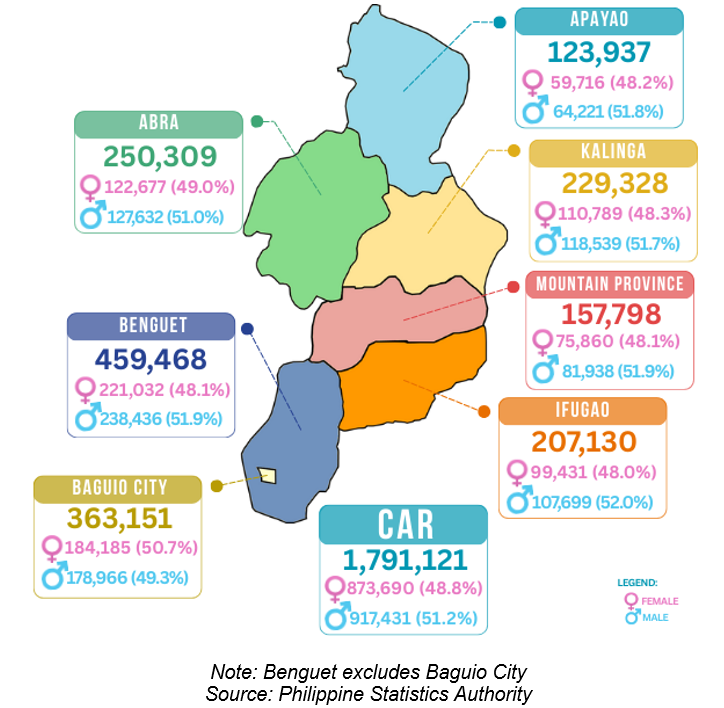
By sex, all provinces in the region, except the City of Baguio, have more male population than male.
The sex ratio in CAR was computed at 105 in 2020. This means that there were 105 males for every 100 females in the region. The provinces of Apayao, Benguet, Ifugao, and Mountain Province all recorded the highest sex ratios with 108, followed by Kalinga with 107. These provinces also had higher sex ratios than the Cordillera region.
Meanwhile, the province of Abra had sex ratios lower than the regional average with 104. On the other hand, the City of Baguio recorded a sex ratio of 97, meaning there were 97 males for every 100 females (Table 1).
Table 1. Sex Ratio by Province/HUC, CAR: 2020
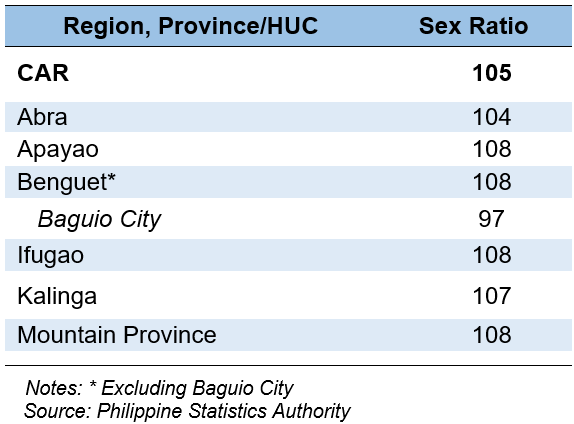
Benguet has the highest youth population
Approximately 19.7% of the region's total household population, or 352,302 individuals, consisted of youth aged 15 to 24 years old. Among this youth population, 51.1% (180,090) were men, while 48.9% (172,212) were women.
In terms of provincial distribution, Benguet had the largest youth population with 88,773 individuals (25.2%), followed by the City of Baguio with 73,988 (21.0%), and Kalinga with 46,731 (13.3%).
When analyzing the sex ratio—the number of men per 100 women—Mountain Province recorded the highest ratio at 110, indicating more men than women. In contrast, the City of Baguio had the lowest sex ratio at 98, reflecting fewer men relative to women. Notably, Baguio City was the only area to register a sex ratio of the youth lower than the regional average (Table 2).
Table 2. Household Population and Sex Ratio of Youth Aged 15 to 24 Years Old
by Province/HUC, CAR: 2020
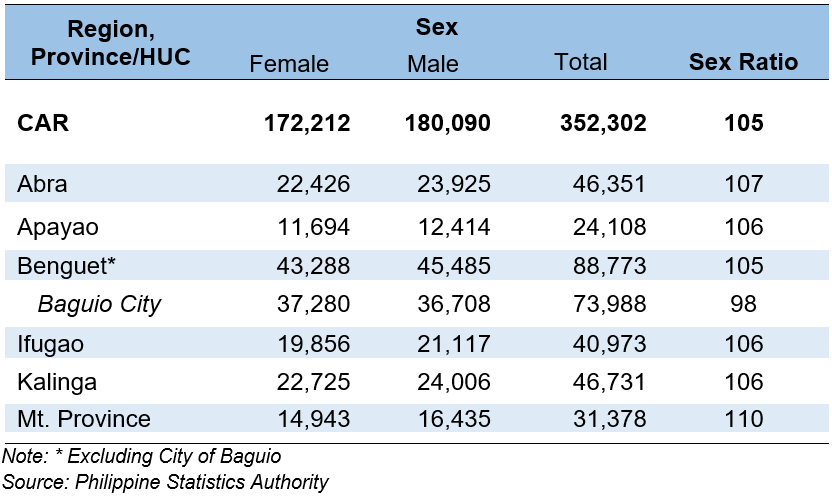
Men outnumbered women in the never married or single marital status
Of the household population aged 10 years old and over, majority in the region were legally married with 656,315 persons (44.9%). This was followed by never married or single and common law or live-in with 583,642 (39.9%) and 136,950 (9.4%) persons, respectively.
By sex, men outnumbered women in legally married, never married or single, and common-law or live-in marital status. Specifically, never married or single men were 9.5 percentage points higher than never married or single women.
On the other hand, more women were recorded in widowed, divorced, separated or annulled, and unknown marital status than men.
Across provinces/HUC, Benguet recorded the most individuals who were legally married, never married or single, and widowed marital status. Meanwhile, the City of Baguio recorded the highest number in the divorced, separated or annulled, and common-law or live-in marital status (Table 3).
Table 3. Household Population 10 Years Old and Over by Marital Status, by Province/HUC, and by Sex, CAR: 2020

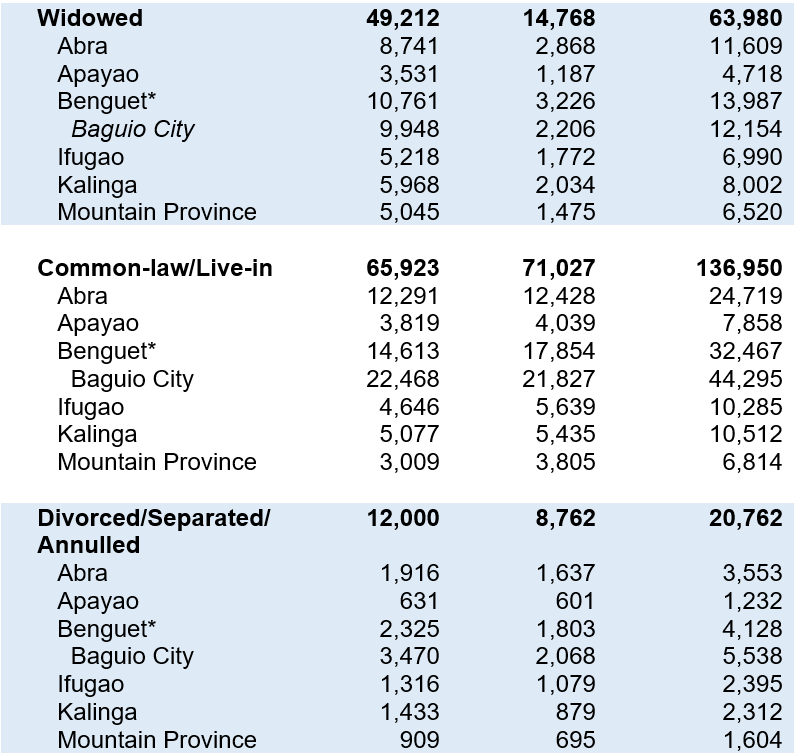
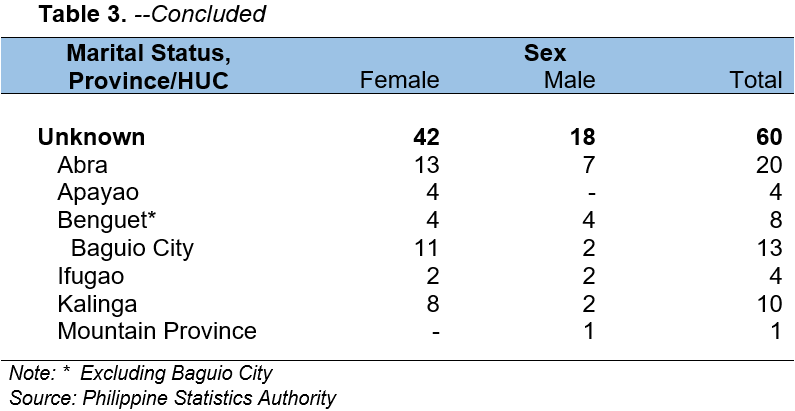
More than half of the household population are Roman Catholic
In the region, a total of 1,106,409 individuals identified as Roman Catholics (excluding Catholic Charismatic), representing a significant portion (61.8%) of the household population. Among the provinces and highly urbanized city (HUC), Abra reported the highest proportion of Roman Catholics, with 207,681 individuals (83.0% of its population). This was followed by the City of Baguio, accounting for 256,551 individuals (70.6%), and Kalinga, with 143,598 individuals (62.6%).
By sex, the top three religious affiliations recorded more men than women across all provinces, except in the HUC of the region (Table 4).
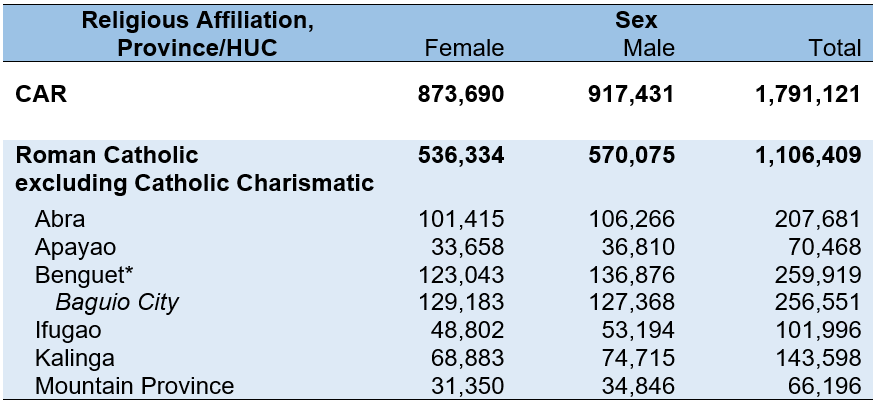
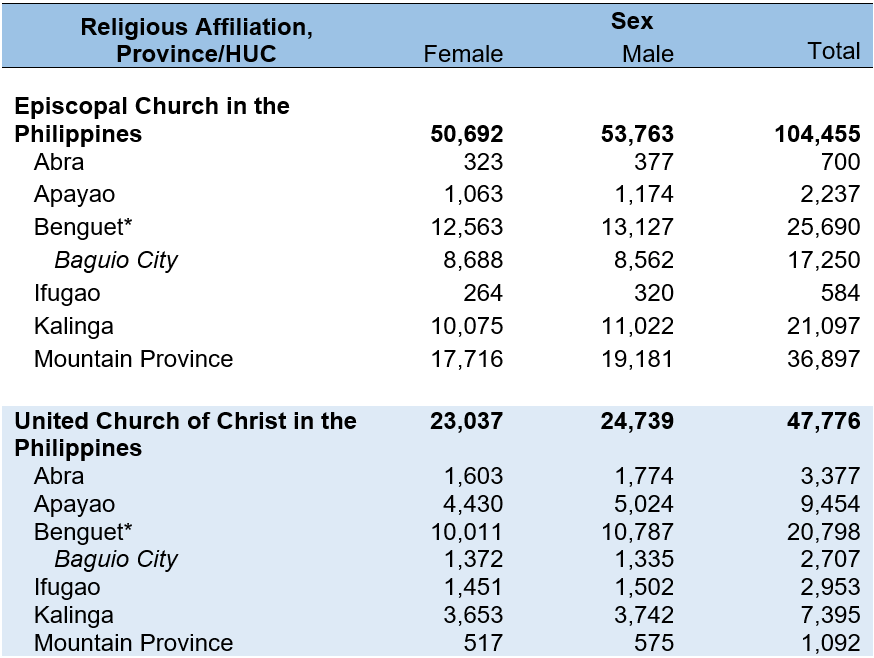
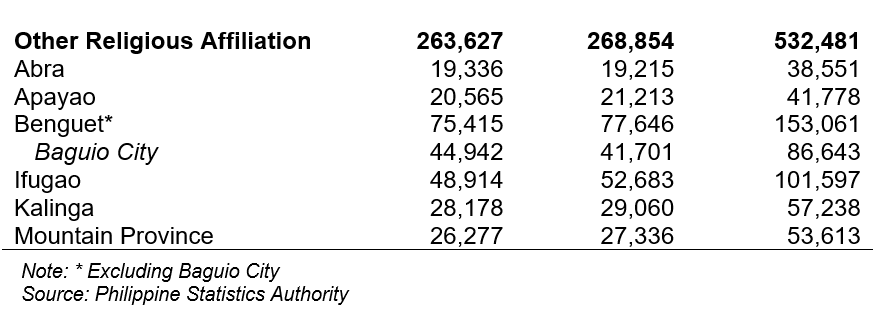
Difficulty in seeing even if wearing eyeglasses is most common domain of functional difficulty
In the Cordillera, 150,757 individuals, or 9.2% of the total household population aged five years and older, were reported to have at least one domain or category of functional difficulty. Among them, 55.1% (83,094 individuals) were women, while 44.9% (67,663 individuals) were men.
By domain of functional difficulty, seeing even with the aid of eyeglasses was the most reported challenge, affecting 103,726 individuals. This was followed by difficulty in walking or climbing steps, reported by 45,033 individuals, and difficulty in hearing even with the use of a hearing aid, affecting 42,201 individuals. Meanwhile, difficulty in communicating using one's usual (customary) language was the least reported, with 11,904 individuals affected.
Across all domains of functional difficulty, more women than men were recorded.
Among the provinces and the highly urbanized city (HUC), Benguet reported the highest number of individuals experiencing difficulties in all domains (Table 5).
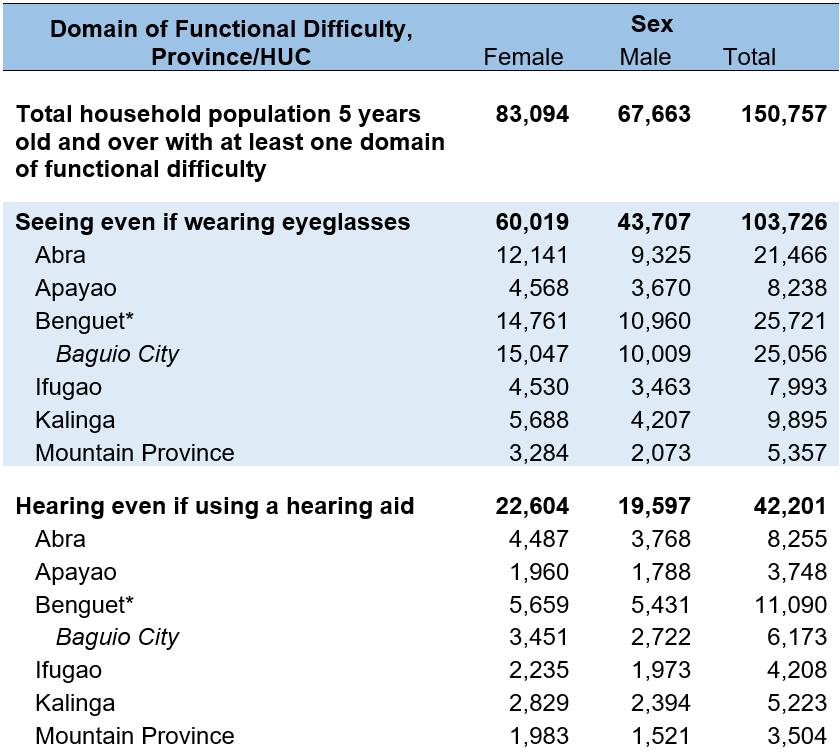
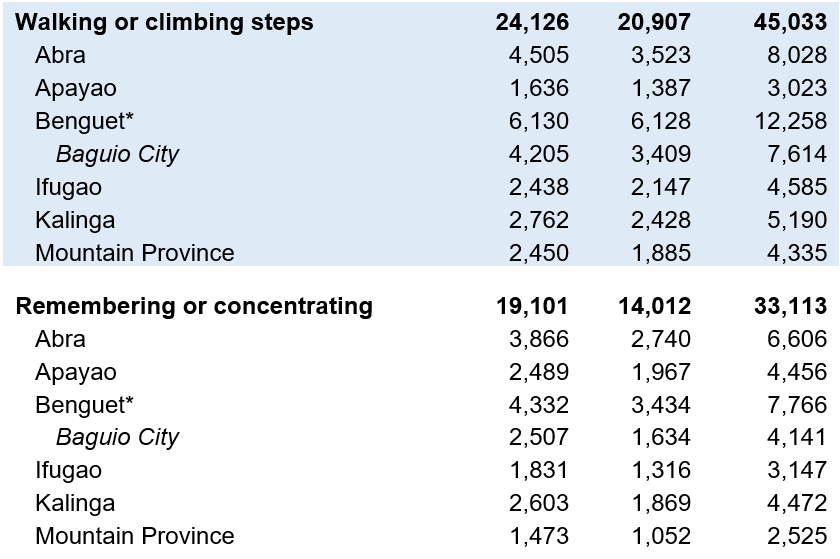
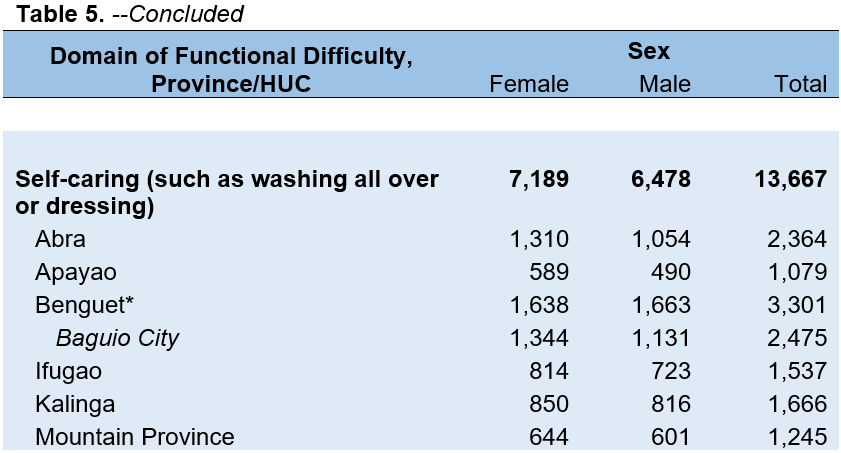
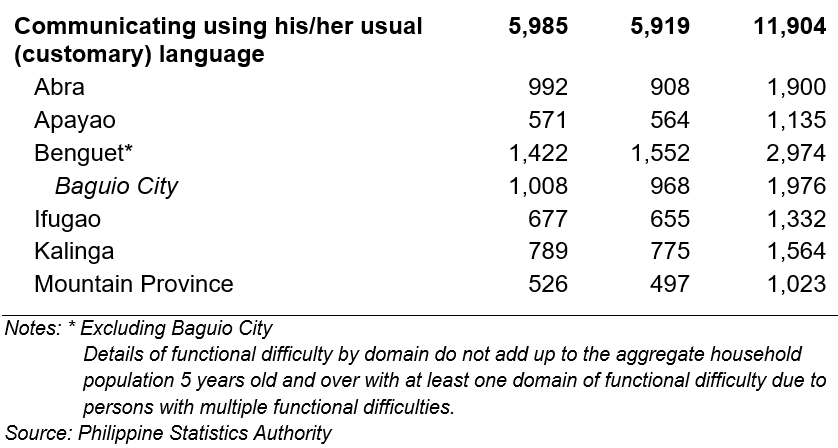
(SGD)
VILLAFE P. ALIBUYOG
Regional Director
Designation Initials Date
CSS AFRBJ 18 March 2025
SSS WBM 17 March 2025
SA LMB 14 March 2025
Technical Notes
The Philippine Statistics Authority (PSA) conducted the 2020 Census of Population and Housing (2020 CPH) in September 2020, with 01 May 2020 as the reference date.
The 2020 CPH was the 15th census of population and the 7th census of housing undertaken in the Philippines since the first census in 1903. It was designed to take an inventory of the country's total population and housing units and collect information about their characteristics.
The Philippine Standard Geographic Code (PSGC) as of April 2022 was used to disaggregate the geographic levels of the 2020 CPH.
Age refers to the interval of time between the person’s date of birth and his/her last birthday prior to the census reference date. It is expressed in completed years or whole numbers.
Ethnicity is a primary sense of belonging to an ethnic group based on descent/blood relation/consanguinity. Ethnic group is consanguineous in nature, meaning, the ties are reckoned by blood and traced through the family tree. Thus, ethnicity refers to the household member’s identity, by descent/blood relation/consanguinity and not by mere choice nor by adoption or confirmation by any ethnic group primarily the Indigenous Peoples (IPs).
Functional difficulty, for the purpose of 2020 CPH, is classified into six (6) core functional domains or categories, that is, a.) seeing (even if wearing eyeglasses), b.) hearing (even if using a hearing aid), c.) walking or climbing steps, d.) remembering or concentrating, e.) self-caring (such as washing all over or dressing), and f.) communicating using his/her usual (customary) language.
Household is a social unit consisting of a person living alone or a group of persons who sleep in the same housing unit and have a common arrangement in the preparation and consumption of food.
Household Population comprises of persons who belong to a household.
Institutional Living Quarter (ILQ) is a structurally separate and independent place of abode intended for habitation by large groups of individuals. Such a Quarter usually has certain common facilities such as kitchen and dining room, toilet and bath, ang lounging area which are shared by the occupants.
Institutional Population comprises of persons who are found in ILQs. They may have their own families or households elsewhere but at the time of the census, they are committed or confined in ILQ, wherein they are usually subject to a common authority or management or bound by either a common public objective or common personal interest.
Religious affiliation refers to a particular system of beliefs, attitudes, emotions, and behaviors constituting man’s relationship with the powers and principalities of the universe. Moreover, religion is either defined as:
(a) religious or spiritual belief of preference, regardless of whether this belief is represented by an organized group or
(b) affiliation with an organized group having specific religious or spiritual tenets
Sex is the biological and physiological reality of being a male or female.
Sex ratio is the number of males per one hundred females in a population.

